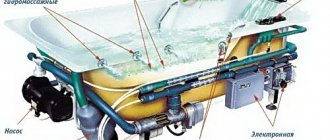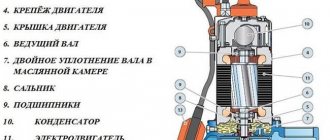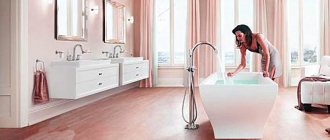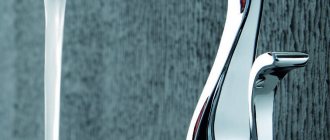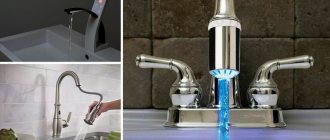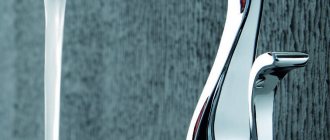Adjusting the water pressure in a sink or shower is not always an easy task. The pressure in hot and cold water pipes is usually not the same. In addition, these indicators tend to change suddenly - a situation that is well known to residents of apartment buildings.
To solve such problems, a wonderful device was invented - a bath mixer with a thermostat. It allows you to obtain a stable flow of water at a given temperature.
Having understood the operating principles and types of modern thermostatic mixers, you can choose the appropriate option and make water treatments in your home extremely comfortable.
Design and principle of operation
Externally, a thermostatic mixer is not too different from a conventional mechanical device. The body has two adjustment knobs, two inlets for hot and cold water, and a spout.
All the most interesting and important things are inside. The heart of such a mixer is a special valve. It is made of special bimetallic plates that sensitively and quickly respond to changes in the temperature of the water entering the chamber of the device.
Some valves use wax, which expands noticeably when heated.
The diagram clearly shows the design of a thermostatic mixer: 1 - hot water; 2 - eccentric; 3 - check valve; 4 - switch; 5 - ceramic pressure regulator; 6 - aerator; 7 — thermal cartridge; 8 — temperature clamp; 9 — temperature adjustment; 10 - cold water
To adjust the valve, a cartridge with a fastening and adjusting screw is used. By rotating the screw, you can set the device to mix water at a certain temperature.
The valve regulates the amount of hot and cold water entering the chamber, and then supplies it to the spout of the device. Most of these faucets allow you to set not only the temperature, but also the pressure of the water coming from the device.
There is no need to adjust the mixer every time you use it, you just need to do it once, the settings will be saved. When you turn on the device, it will take some time to obtain a flow of the desired temperature.
If the mixer is set up correctly, this usually only takes a few seconds.
For safety reasons, the mixer adjustment screw is equipped with a special limiter that does not allow the water to heat to a dangerous level. If cold water suddenly stops flowing into the mixer, the water supply to the spout is completely blocked and is restored only after normal water supply is restored.
In addition, the device does not allow the water to become too cold. This function is relevant for families with growing children who can already bathe on their own, but are not yet able to monitor the temperature of the water in the bath.
Required additional equipment
(mandatory, purchased separately)
~₽30 – Plug (cap, brass) G½”-BP (Internal Thread) ~₴18 – Plug (cap, stainless steel) G½”-BP (Internal Thread) ~₽39 – Plug (cap, stainless steel) ~₽39 – Plug (cap, stainless steel) cast iron) G½"-BP (Internal Thread)
~₽203 – Diverter “FRAP” art. FBBB-3 – G¾_ВР – input, G¾_НР and G½_НР – outputs; The depth of the socket G¾_НР (for the spout) is 18.5 mm – quite suitable (d.b. 16 mm); The diameter of the spout socket is Ø18.7mm – the spout will seal without problems (d.b. Ø18.4÷19.0mm);
~₽300 – Spout for high-pressure mixer L-shaped. 30 cm DY-J15 Determine (and select) the optimal length; There are offers on the market from 20 to 50 cm.
Recommendations for choosing a mixer
Although the operating principle of different mixers is the same, the models of these devices are quite diverse. First of all, you should decide on the purpose of the mixer:
- for a washbasin, equipped only with a spout;
- for a shower in which there is no spout, water flows only to the shower head;
- for shower and washbasin at the same time, the water supply is switched with a special handle;
- for the kitchen sink.
It should be noted that thermostatic mixers specially designed for bidets or hygienic showers can also be found on sale. The installation of such models is especially important if the house has elderly or sick residents who need special care.
Faucets with thermostats designed for baths and showers have two water outlets: to the spout and to the shower head.
In addition, you can choose a mixer with mechanical or electronic control. Mechanical models are considered more reliable, easier to repair and cost a little less. Electronic faucets are equipped with a beautiful display, which makes operating the device much easier.
But they are more expensive, and repairing them in case of breakdown is much more difficult.
The mechanical model of the mixer with a thermostat looks laconic and looks very similar to a regular mixer: two valves and a spout. Mechanical models are very reliable and easier to repair than electronic devices.
A significant difference between an electronic mixer and a mechanical one is the need to connect the power supply, which is done using batteries or an AC adapter.
They are necessary for the operation of electronic temperature sensors and the screen on which data on the operation of the device is reflected. This could be water temperature, pressure, etc. Such a device is controlled using buttons or directly from the touch panel.
There are also models with remote control.
In everyday life, electronic faucets are not used very often, since cheaper mechanical models cope more than satisfactorily. Often complex and expensive electronic devices are used in large facilities, such as swimming pools, medical institutions, saunas, etc.
Modern models of electronic faucets with a thermostat are equipped with a convenient touch screen, which displays the current settings and also contains controls
Faucets also differ in the installation method. They are installed in the traditional way, on a horizontal surface or on a wall, but you can choose a model for mounting on the side of the bathroom.
There are also faucets that can be hidden in the wall. Such built-in models are accompanied by a special container housing, which is placed in the thickness of the wall.
The built-in faucet with thermostat is characterized by a laconic design, but if the device needs to be repaired, access to it may be difficult
There is also a so-called centralized thermostat mixer. This device supplies hot water at a given temperature to all taps in the house at once.
It sounds great, but in practice this device is not nearly as convenient as we would like. This faucet does not provide the ability to make water hotter for a bath or shower. You will have to either increase the water temperature for the entire house, or be content with not very comfortable water procedures.
Using such a device makes sense if there are several washbasins in the room. You should use a separate thermostat for the bath and shower.
Features and functions of electronic models
A bathroom faucet with an electronic thermostat is a more expensive and technically complex model that requires batteries or an AC adapter. The choice of temperature and water pressure is based on electronic temperature and pressure sensors, which not only regulate the water supply automatically, but also display the indicators on special screens. Such devices can have push-button, touch, or remote control. But in domestic conditions, such equipment is unnecessary and is more often used in medical institutions, public restrooms, swimming pools or saunas.
Mixer with electronic thermostat
Advantages and disadvantages
The advantages of using thermostatic mixers for baths and showers are obvious and undeniable:
- despite the complex design, the device is extremely easy to use;
- provides water supply at a consistently high temperature;
- it is not difficult to install it yourself;
- water always flows with suitable pressure;
- the device is safe even in emergency situations, for example, when cold or hot water is turned off;
- reduces water consumption, which, without the use of a thermostatic mixer, was lost when setting the temperature manually;
- allows you to save energy for heating water with autonomous hot water supply.
Among the disadvantages, one can note mainly the high price. Although owners of houses and apartments who have tested this device in practice consider their expenses to be quite justified.
Another problem that often causes problems with thermostatic mixers is the low quality of tap water, especially typical for centralized water supply in apartment buildings.
Over time, the device becomes clogged, its performance deteriorates, and unpleasant noise appears during use.
In the best case, the problem can be eliminated by cleaning the device, but sometimes the mixer simply breaks down and has to be completely replaced. You can increase the service life by using coarse filters installed at the inlets of the mixer.
Some models are equipped with special meshes that are supposed to filter out debris, but practice shows that the effectiveness of these materials in combination with Soviet-built water pipes is low.
Another problem is low water pressure in the home plumbing. The passport of each mixer indicates the minimum pressure at which the operation of the device will be sufficiently effective. If the necessary indicators are not available, purchasing and installing a mixer with a thermostat does not make much sense.
The situation can be corrected by installing a special pump that will increase the pressure in the water supply. Thus, in order to install a thermostatic mixer in conditions of poor-quality tap water or low water pressure in the system, additional costs will be required.
These points should be taken into account when planning to purchase a thermostatic mixer. You can adjust the water pressure using such a device only in a decreasing direction.
It should also be remembered that thermostatic mixers, especially their electronic version, are quite difficult to repair. This can hardly be done at home; you need to contact specialized service centers. In addition, not all problems can be solved with repairs.
But subject to the operating conditions recommended by the manufacturer, a mixer with a thermostat can operate flawlessly for several years.
Sink and kitchen faucets
Such mixers are not so common, since the need for them is small. These are often models of an open mounting system that are installed directly on the sink and have one lever for turning on the water and a spout.
Models for the kitchen differ in design and specific spout - a more curved gooseneck, but the principle of their operation is no different.
Thermostatic basin mixer
A bathroom faucet with a thermostat has a lot of advantages and is becoming one of the necessary plumbing devices in modern homes, but its installation and installation require certain skills, a special space in the bathroom and excellent knowledge of the principles of the plumbing system and the mechanism itself.
Minuses
- Installation feature . The hot water outlet must be on the left, as required by Euro standards. In older houses, the arrangement of water supply pipes is different, which often has to be changed if specified in the operating instructions. Otherwise, the sensor in wall-mounted models will not function correctly or may break.
- Work when the water is turned off in one of the pipelines. The water supply from the other one also stops automatically. Although there are models that have a special switch for opening the valve manually. Then you can use the existing liquid.
- Requirement of power supply . Electronic thermostats are powered by a battery, which needs to be changed periodically, or from the mains via an AC adapter.
- High purchase cost compared to a traditional faucet. But it pays off during operation.
- Manual setting of parameters in mechanical varieties. It takes a little longer, but such equipment is simpler and cheaper than its electronic counterparts.
The design of electronic models is more complex than that of their mechanical counterparts. The complexity requires skill in installation and repair, which will require calling a qualified specialist and high costs. But such plumbing looks more modern and displays additional parameters on the screen.
Subtleties of installing a device with a thermostat
Installing a faucet with a thermostat in the bathroom is a fairly simple process that can be handled without the involvement of a qualified technician. Moreover, the parameters and requirements for its installation are the same as for standard valve models.
When doing installation, first of all, you need to ensure that hot water is supplied to the mixer at the same time as cold water. In addition, you must adhere to the installation diagram. If you make a mistake, the mixer will not work.
Installation can be carried out in two ways:
- open;
- closed.
Open method . There are no particular difficulties during installation. After all, all you need is to connect the hoses and secure the faucet to the wall, sink, bathtub rim or shower stall.
Closed installation . In this case, you will need to install an additional false wall made of plasterboard. After all, it is necessary to ensure that only levers or buttons that regulate the temperature stick out from the wall.
The only disadvantage of hidden installation is that in case of a breakdown you will have to open the wall
If we compare two methods of installing a mixer, then each of them has its own advantages and disadvantages. But in the case when high-quality thermostatic equipment was purchased, it is recommended to engage in hidden installation.
After all, then the bathroom design will be freed from unnecessary details, which will make the interior more harmonious and luxurious.
Main selection criteria
A huge assortment of faucets with thermostats creates a lot of problems for the unprepared buyer. After all, choosing the optimal model from this variety is quite difficult and it can take more than one hour.
What to look for before buying?
To find a device that will allow you to shower comfortably, will last at least several years and will not stand out too much in the bathroom design, you need to pay attention to a number of parameters.
Important characteristics:
- material used to make the case;
- valve type;
- presence of a fuse;
- connection method;
- minimum possible working pressure;
- manufacturer.
Before going to the store, it is recommended to familiarize yourself with the products of online stores. This decision will allow you to decide in advance on the optimal model for your bathroom.
Case material
The service life of the mixer largely depends on the reliability of the housing. Accordingly, this factor must be given attention first.
The most reliable and, accordingly, expensive materials are considered to be brass, bronze, and copper. If the appearance of the faucet comes first, and not its strength, then you can give preference to a ceramic product.
Manufacturers also offer models made of plastic and aluminum-silicon alloy (silumin). Yes, these devices are quite cheap, but they will not last very long.
Which valve is better?
An important component of any thermostatic faucet is the valve. This element is often made of ceramic, rubber or leather. The last two materials are used to produce cheap models, which is why many problems arise.
A leather or rubber valve wears out very quickly. This can cause many unpleasant situations in the future. But replacing such a part will not be difficult. The procedure is similar to the process of replacing the gasket in a regular faucet without a thermostat.
Leather and rubber are soft and short-lived materials. It is because of this that quite often a problem arises associated with damage to the valve seat. If solid particles get under the element from the water, the part is damaged, which leads to a flood. Therefore, if you find any problems, you must urgently contact a specialist.
A ceramic valve is more reliable and durable. In this case, a special design prevents debris from getting under the element and, accordingly, the saddle remains intact.
The ceramic valve pushes out all solid particles trapped under it. Moreover, the element has a graphite coating on top, which significantly extends the service life of the mixer.
When operating thermostatic equipment with a ceramic valve, do not use brute force when closing the valve. Failure to comply with this rule will result in the faucet head breaking.
Therefore, to shut off the water flow, you should turn the valve all the way, and the ceramics, precisely adjusted to size, will do the rest.
Why is a safety button needed?
Every more or less well-known manufacturer of thermostatic mixers installs a fuse in their products. This element prevents accidental changes in water temperature. After all, there is always a risk that with one awkward movement you can turn on boiling water and get severe burns.
Most often, the element is made in the form of a button, painted red. In this case, to change the water temperature, you need to release the fuse. This useful feature will be especially relevant for parents with young children.
Mixer connection diagram
When choosing plumbing equipment with a thermostat, it is imperative to ask the seller about the connection diagram for the water pipes to the device. After all, if you connect everything incorrectly, the mixer will break and will need to be repaired, which, as mentioned above, will be quite expensive.
To connect a thermostatic mixer in a bathroom or shower, you can use flexible hoses
Check that the equipment is adapted to Russian standards. Remember that one question will eliminate the need to change the pipe configuration.
Minimum operating pressure
An important characteristic is the presence of sufficient water pressure in an apartment or private house. The vast majority of devices operate at a pressure of 0.5 bar.
If in fact it is lower, the equipment will not function properly. Accordingly, there is simply no point in installing it in your bathroom.
Which manufacturer is better?
The plumbing equipment market is regularly updated with new products. But if you need to purchase a thermostatic mixer of the highest quality, then the best solution would be products from Oras , Jacob Delafon , Grohe , and Hansgrohe .
For the average buyer, products from the Oras . The company always tries to maintain the most favorable balance between product quality and affordability. In production, the company primarily uses plastic or brass.
The cost of thermostatic mixers from Oras is relatively low and amounts to about 180-200 dollars
Since its founding, the French manufacturer Jacob Delafon has established itself as a reliable supplier of brass plumbing equipment. Its distinctive feature is the provision of a five-year warranty on all faucet models.
As for appearance, Jacob Delafon products have a classic design. Equipment costs typically range from $150 to $450.
Grohe boasts the largest range of faucets . This manufacturer offers products equipped with a wide variety of functions and made in various styles.
Grohe uses brass in production. Therefore, it is not surprising that faucets from this brand last at least 10 years.
Although Grohe products differ from their analogues in quality and reliability, they are quite expensive. On average, the price of faucets from this brand is $300-700
Hansgrohe , also deserves respect . Their thermostatic mixers are distinguished by their most laconic design and high durability. Chrome plated steel is used for the manufacture of products.
Hansgrohe faucets are the ideal solution for small bathrooms. After all, the equipment is compact and relatively inexpensive - around $200.
Hansgrohe provides a 5-year warranty on all its products, which is quite good considering the stated price.
Almost all manufacturers offer the buyer several lines of mixers with thermostats. The assortment includes simple models, the design of which focused on their functionality.
But the catalog often includes several products that represent a real work of contemporary art.

